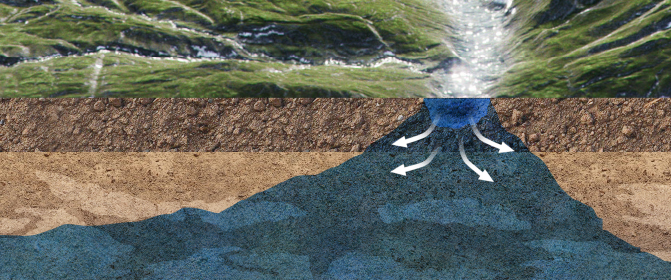HOW THE WATER BANK WORKS
Making the most of our natural infrastructure
The Water Bank uses the Sacramento region’s natural infrastructure, our groundwater aquifer, as a reservoir for depositing water during wet times for withdrawal during dry times.
This natural infrastructure is enhanced with a collection of groundwater wells, pumps and pipes, all managed as one integrated system, that make it possible to make deposits and withdrawals from various locations.
WATER BANK PROJECTS
The Water Bank is a system of groundwater wells, pumps and pipelines that allow local water providers to pump out and refill under groundwater reserves to serve local customers.

Making Deposits and Withdrawals
In the Sacramento region, deposits into the Water Bank happen primarily through the following three ways:
Rain falls and percolates under ground, or water flowing into creeks and rivers seeps through the sand and gravel into the aquifer. This helps replenish the aquifer.
In Lieu Recharge
Water providers enhance
natural recharge by strategically
turning off groundwater wells
during wet times and using
surface water instead. This
helps our aquifer refill.
The Sacramento region is uniquely suited to expand this method with the Water Bank.
Direct Artificial Recharge
Such as Aquifer Storage and Recovery (ASR). Using ASR, water providers deposit treated water into the Water Bank during wet times using specially designed wells that can both recharge (inject) and recover (extract) water.
The City of Roseville currently uses this method, and others in the region are working to add ASR wells.
Withdrawals from the Water Bank happen through a system of groundwater pumps and pipelines, that draw
and treat water from the aquifer, and then deliver it to homes and businesses.
Proven to be Effective
Local water providers have been successfully practicing water banking on a smaller scale via an existing 20-year program of conjunctive use.
Conjunctive use is the strategic use of both surface water and groundwater to maximize total water availability long term. During wet times, when lakes and rivers are full, water providers shift to using more surface water. This allows our groundwater aquifers to refill. During dry times, local water providers shift to using more groundwater. This leaves more surface water in rivers to sustain the environment.
The result: Increased groundwater levels and a case study for how water banking is effective even during a megadrought — the driest two decades in at least 1,200 years.
There is great potential to expand water banking to meet the needs of our community and environment in a future with climate change. And we need your support to advance this critical water security project.





